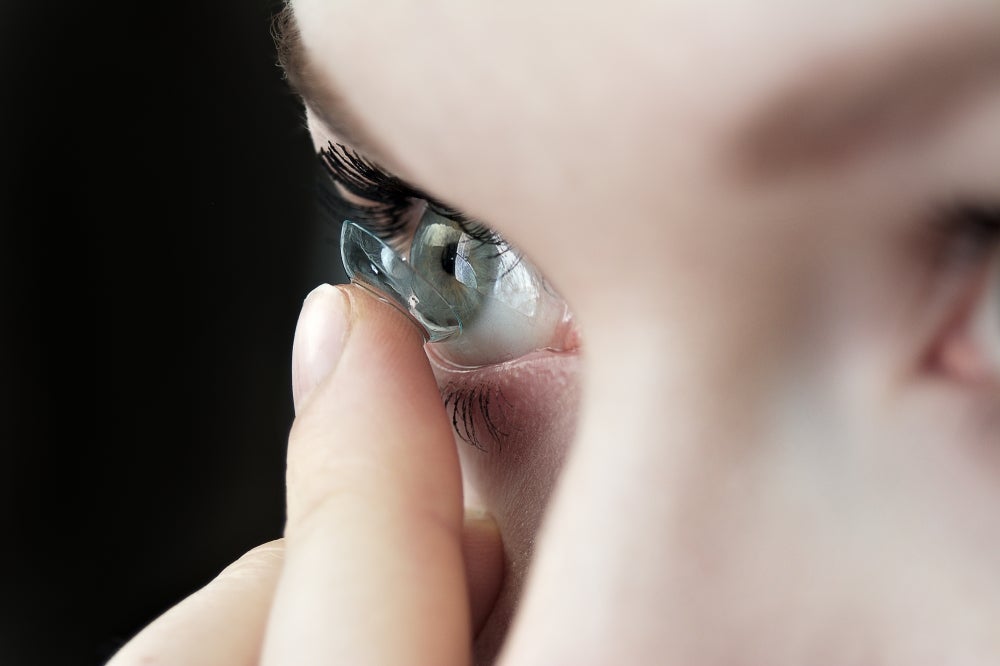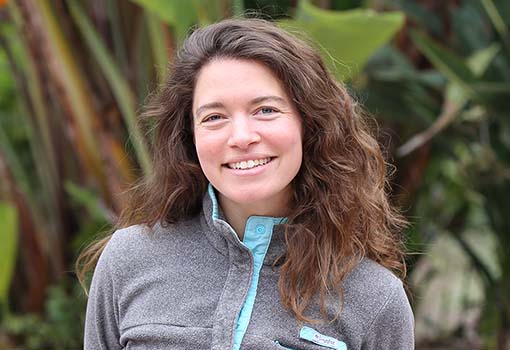
A Source of Friction

Many soft biomedical devices, such as silicone implants and contact lenses, operate while in direct contact with living cells and tissues. They may be designed to adjust their form or appearance, or to improve their interactions inside the body. A problem with such devices is that soft implant surfaces may induce inflammation by unintentionally increasing friction when the outer surface of the device slides against living cells and tissues.
Angela Pitenis, an assistant professor in UC Santa Barbara’s Materials Department, has received a prestigious Early CAREER Award from the National Science Foundation (NSF) to study this problem, with an eye to improving medical devices used by millions each year. The NSF Faculty Early Career Development program, which encourages junior faculty to pursue cutting-edge research and advance excellence in education, will provide Pitenis with nearly $600,000 in funding over five years.
“The Early CAREER award is a tremendous honor,” said Pitenis, who works to better understand interfacial phenomena, such as friction, adhesion and wear, between soft materials and living cells. “As an experimentalist, research support is everything. This award provides funding for a dedicated Ph.D. student researcher, essential reagents and recharge fees for the use of shared experimental facilities and funding for outreach programs focused on science communication and broadening participation among underrepresented and underserved groups in science, technology, engineering and mathematics. I am very excited that the NSF supports my research directions and my role as a teacher-scholar.”
“I offer sincere congratulations to Professor Angela Pitenis on receiving the prestigious NSF Early CAREER Award,” said Tresa Pollock, interim dean of the UCSB College of Engineering (COE) and Alcoa Distinguished Professor of Materials. “She continues a strong and growing tradition of our stellar young faculty receiving national recognition for their innovative research. We look forward to witnessing her continued success on this project and those she will pursue in the future.”
Pitenis’s project,“Dynamics of Fragile Interactions,” addresses a gap in the knowledge and understanding of lubricity, or the reduction of friction and resistance to motion in soft aqueous gels, and in biotribology, which is the study of friction, wear and lubrication in biological systems.
“My project is inspired by the need for soft biological materials that enable lubricity, despite persistent and wide-ranging tribological challenges, such as mechanical stresses that are created when surfaces interact in relative motion,” said Pitenis, who joined the UCSB materials department in 2018.
The project is guided by the hypothesis that sliding surfaces in nature reduce friction through a delicate balance of fracturing and rapidly rehealing crosslinks between macromolecules in aqueous solutions. It’s a phenomenon that occurs in the ocular tear film, which physically separates the sensitive surfaces of the cornea and eyelid by a span of about 5 micrometers (µm). Although the tear film is composed of over 90% water — a poor engineering lubricant — it provides robust biological lubrication over tens of thousands of eyeblinks each day. In this system, biology has engineered elegant networks of gel-forming proteins, called mucins, to enable resilience through fragility.
“By easily fracturing during sliding and then rapidly recovering at rest, the fragile gel networks act like mechanical fuses which quickly dissipate high stresses and protect underlying cells and tissues,” said Pitenis. “Our project will help explain the mechanics of aqueous gels in biological lubrication, which could lead to the engineering of more reliable, responsive, resilient and responsible biotribological interfaces.”
Since biological materials are often difficult to source in large quantities and subject to high sample-to-sample variability, Pitenis’s lab will design synthetic models of biological gels using high water content hydrogels, which are three-dimensional crosslinked networks of hydrophilic polymer chains swollen in water.
“These model materials can provide fundamental insights into complex lubrication mechanisms of biological interfaces like the aqueous gel networks of the tear film,” she said.
Researchers in the Pitenis lab will also use its custom-built scientific instruments, called tribometers, to measure friction and normal forces during the sliding of synthetic transparent gels, and will use optical microscopy techniques to study the interfacial phenomena. Observing the contact will allow researchers to improve their understanding of the mechanics and dynamics of the interface.
“Resilience from fragility is an emerging concept,” said Pitenis. “While many studies in materials science over the past several decades have focused on ways to make soft materials tougher and more fracture-resistant, these traits may actually work against lubricity. Establishing that fragile interfaces provide robust protection and low friction will extend the study of the dynamics of fragile interfaces into many fields focused on soft materials, including biology, chemistry, physics, mechanics and medicine.”
In addition to demonstrating self-healing surface gel layers that dynamically re-gel during recovery, the lab will explore the incorporation of degradable chemistries into the gels in an effort to recycle synthetic polymers and products made from materials.
Pitenis also plans to use the CAREER award to increase the participation and retention of women and English-learning minorities in STEM by engaging in outreach in the local community and participating in the UCSB Material Research Laboratory’s Partnership for Research and Education in Materials (PREM) program. PREM provides ten-week summer research internships for students from UCSB and the University of Texas El Paso.
“I am particularly excited to work with undergraduate students because they add tremendous value to research labs, often by asking deceptively simple yet endlessly complicated questions that can spark deep research discussions and occasionally even new research projects!” said Pitenis, who also plans to pursue international collaborations with the University of Alberta and the University of Leeds.
Pitenis is among the ten junior faculty members from the College of Engineering who have received CAREER awards since April 2020. UCSB ranks first among public universities in the percentage of eligible junior faculty who received the awards from 2017-2021.
“I am incredibly grateful for my graduate and undergraduate students who have kept me motivated and inspired during a global pandemic,” Pitenis added. “I hope this award encourages students to consider careers in research, education, and scholarship.”



